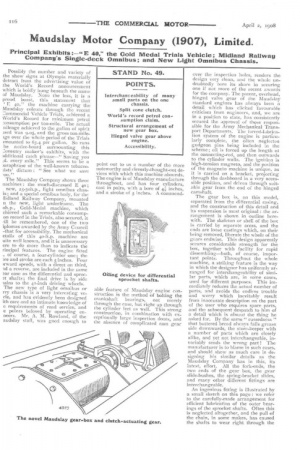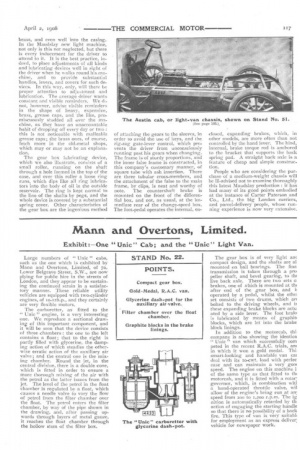Maudslay Motor Company (1907), Limited.
Page 26

Page 27

If you've noticed an error in this article please click here to report it so we can fix it.
Principal Exhibits:—"E 40," the Gold Medal Trials Vehicle; Midland Railway Compang's Single-deck Omnibus; and New Light Omnibus Chassis.
Possibly the number and variety of the show signs at Olympia materially detract from the advertising value of the World's Record announcement which is boldly hung beneath the name of Maudslay. None the less, it is a proud boast, this statement that E 40," the machine carrying the Maudslay colours through the recent
ommercial Vehicle Trials, achieved a World's Record for minimum petrol -:onsumption per ton-mile. The actual nileage achieved to the gallon of spirit Ised was 9.05, and the gross ton-milerge over the whole period of the Trials imounted to 63.4 per gallon. So runs he notice-board surmounting this -2oventry maker's exhibits, with the idditional catch phrase—" Saving you (.1. every mile." This seems to be a )araphrase of the well-known tobaccolists' dictum : " See what we save -ou."
The Maudslay Company shows three nachines : the much-discussed E 40; new, 25-3oh.p., light omnibus chasis ; and a special omnibus body, for the lidland Railway Company, mounted n the new, light underfrarne. The oh.p., Gold-Medal machine, which chimed such a remarkable consumpon record in the Trials, also secured, it till be remembered, one of the two iplomas awarded by the Army Council -that for accessibility. The mechanical etails of this 4o-h.p. machine are uite well known, and it is unnecessary ere to do more than to indicate the rincipal features. The engine fitted
of course, a four-cylinder one ; the )re and stroke are each 5 inches. Four )rward speeds, with a direct on third, id a reverse, are included in the same ear case as the differential and spreeet shafts ; the final drive is by side tains to the 4r-inch driving wheels. The new type of light omnibus or rev chassis is a very interesting vecle, and has evidently been designed ith care arid an intimate knowledge of e requirements of road service, and e points beloved by operating enneers. Mr. A. M. Rowland, of the audslay staff, was good enough to point out to us a number of the more noteworthy and cleverly-thought-out devices with which this machine abounds. The engine is of Maudslay manufacture throughout, and has four cylinders, cast in pairs, with a bore of inches, and a stroke of 5 inches. A commend
able feature of Maudslay engine construction is the method of bolting the crankshaft bearings, not merely through the case, but right up through the cylinder feet as well. This strong construction, in combination with exceptionally large inspection doors, and the absence of complicated cam gear
over the inspection holes, renders the design very clean, and the whole undoubtedly bore its share in securing one if not more of the recent awards for the company. The patent, overhead, hinged valve gear of the Maudslay standard engines has always been a detail which has elicited favourable criticism from engineers, and, we are in a position to state, has consistently secured the approval of those responsible for the Army Mechanical Trans-. port Departments. The forced-lubrication system of the engine is particularly complete, the often neglectea gudgeon pins being included in the scheme; oil is forced up the length of the connecting-rod, and then outwards to the cylinder walls. The ignition is high-tension magneto, and the position of the magneto machine is unique, as it is carried on a bracket, projecting through the dashboard in a very accessible position, and driven through suitable gear from the end of the hinged camshaft.
The gear box is, on this model, separated from the differential easing, and the construction of this detail and its suspension is most original : the arrangement is shown in outline herewith. The skeleton or shell of the box is carried by separate arms, and the ends are loose castings which, on their being removed, liberate the whole of the gears endwise. This design apparently secures considerable strength for the box, together with facility for rapid dissembling—both, of course, important points. Throughout the whole machine, a striking feature is the way in which the designer has uniformly arranged for interchangeability of similar parts, which arc, in some cases, used for different purposes. This immediately reduces the actual number of parts, and avoids the endless trouble and worry which inevitably result from inaccurate description on the part of the user who requires spare parts, and the subsequent despatch to him of a detail which is almost the thing he asked for. By the same " cussedness " that buttered bread always falls grease side downwards, the store-keeper with a number of parts which are closely alike, and yet not interchangeable, invariably sends the wrong part ! The
manufacturer is to blame in such cases, and should show as much care in de
signing his similar details as the
Maudslay Company has in this, its latest, effort. All the fork-ends, the two ends of the gear . box, the -gear slide-bushes, the spring-bracket slides, and many other different fittings are interchangeable.
An ingenious fitting is illustrated by a small sketch on this page : we refer to the carefully-made arrangement for
efficient lubrication of the outer bearings of the sprocket shafts. Often this is neglected altogether, and the pull of the chain, in some makes, has caused the shafts to wear right through the
brass, and even well into the casing. In the Maudslay new light machine, not only is this not neglected, but there is every inducement for the driver to attend to it. It is the best practice, indeed, to place adjustments of all kinds and lubricating devices well in sight of the driver when he walks round his machine, and to provide substantial handles, levers, and covers for such devices. In this way, only, will there be proper attention to adjustment and lubrication. The average driver wants constant and visible reminders. We do not, however, advise visible reminders in the shape of heavy, expensive, brass, grease caps, and the like, promiscuously studded all over the machine, as they have an unaccountable habit of dropping off every day or two : this is not noticeable with malleable grease caps; the brass ones, of course, fetch more in the old-metal shops, which may or may not be an explanation.
The gear box lubricating device, which we also illustrate, consists of a small roller, running on the shaft through a hole formed in the top of the case, and over this roller a loose ring runs, which dips like all ring lubricators into the body of oil in the outside reservoir. The ring is kept normal to the line of the shafts by pegs, and the whole device is covered by a substantial spring cover. Other characteristics of the gear box are the ingenious method of attaching the gears to the sleeves, in order to avoid the use of keys, and the zig-zag gate-lever control, which prevents the driver from unconsciously running past his gears when changing. The frame is of sturdy proportions, and the inner false frame is constructed, in this company's customary manner, of square tube with ash insertion. There are three tubular cross-members, and the attachment of the false to the main frame, by clips, is neat and worthy of note. The countershaft brake is mounted on the front of the differential box, and not, as usual, at the immediate rear of the change-speed box. The foot-pedal operates the internal, en closed, expanding brakes, which, in other models, are more often than not controlled by the hand lever. The hind,. internal, brake torque rod is anchored to the bracket that supports the back spring pad. A straight back axle is a feature of cheap and simple construction.
People who are considering the purchase of a medium-weight chassis will be ill-advised not to examine thoroughly this latest Maudslay production : it has had many of its good points embodied at the instance of Carter Paterson and Co., Ltd., the big London carriers, and parcel-delivery people, whose running experience is now very extensive.




























































